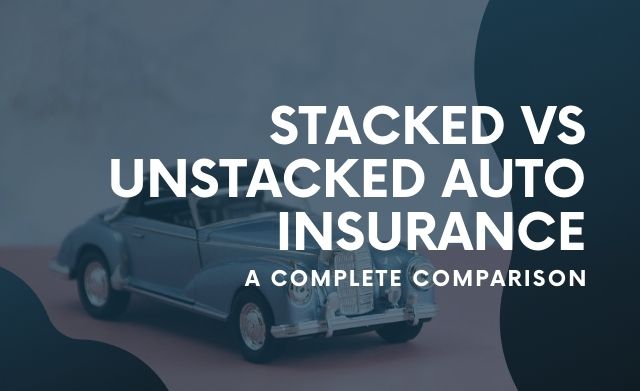
Auto insurance policies often make car owners confused and result in a wrong selection. To clarify that confusion, this article will elaborate on the difference between stacked and unstacked auto insurance in order to help you choose the right one.
Car or auto insurance policy came into existence more than a century ago in the US. Newyork was the first state to introduce this law, and gradually it became a reliable legislative step for most car drivers all over the country.
There are various types of auto insurance in the United States. Some insurance companies may entice you to choose a particular policy for their profit, but you can select a much better one if you gain a little more knowledge on that.
However, insurers will always help you by providing information, but you must read what policy they are offering and how that policy will help you. Wouldn’t you choose the option with optimal facilities? For that reason, this article is going to compare two insurance options for your convenience.
Stacked and unstacked insurance may not be heard by many car owners. Well, it’s because, in some states, auto insurance agencies allow you to stack your uninsured and underinsured motorist coverage for more than one vehicle under one insurance policy. While in some other states, they only allow uninsured motorist coverage or any other options for a single car. That means you are not allowed to stack multiple policies under one single insurance.
So, before you opt for an insurance policy, make sure to get all the information on how far coverage your insurance companies may provide you based on the state law.
Stacked auto insurance is a particular car insurance policy that combines uninsured or underinsured motorist coverage limits. In contrast, unstacked auto insurance is where you are not allowed to combine uninsured or underinsured motorist coverage limits.
Table of Contents
Comparison chart
| Difference | Stacked | Unstacked |
| Meaning | Insurance that combines UM or UIM coverage limit | Insurance that doesn’t combine UM or UIM coverage limits |
| Applied to | Single and multiple vehicles | Single vehicle |
| Amount of coverage limit | Higher | lower |
| Protection | More protection | Less protection |
| When on other vehicles | Applied | Not applied |
| Cost | More | less |
Uninsured and underinsured motorist coverage
Before we jump into stacked vs. unstacked auto insurance, two things should be made clear: Uninsured motorist (UM) and Underinsured Motorist (UIM) coverage.
Uninsured motorist coverage is used when you get involved in a collision with a non-insured vehicle. There are two types of uninsured motorist insurance, stacked and unstacked.
UM, coverage includes both medical and property injury. The bodily injury coverage is known as UMBI or Uninsured motorist bodily injury coverage.
On the other hand, when we say underinsured motorist coverage, this term may vary based on different states and insurance policies. You use the underinsurance motorist coverage when your vehicle collides with an underinsured car. This means the car at fault doesn’t meet the insurance limit to cover your bodily and property damage. Underinsured motorist coverage includes medical expenses, known as UMBI (Underinsured motorist bodily injury).
So how to claim the UM or UIM coverage? For example, let’s say you get in a collision with a driver who doesn’t have auto insurance. What you do in the first place is you call the police to inform them about that incident and file a report.
Next step, you call your insurer to inform them that the driver at fault doesn’t have auto insurance. Then you send the insurers the police record.
Claiming the expenses for your damages will be processed by the insurance company.
UM, and UIM insurance is required in many states. But not in all. States like Los Angeles, Illinois, Colorado, California don’t allow you to use Uninsured motorist insurance.
What is Stacked auto insurance?
The word stacked indicates that you can combine multiple coverage limits under one policy. If your state allows you to stack your vehicle, you are actually a lucky person. But unfortunately, not all states permit that.
Stacked auto insurance may apply for multiple vehicles and protect you from damage caused by an uninsured or underinsured driver. It also increases the coverage limit.
A coverage limit (or limit of coverage or policy limit) is the amount of money that the insurer pays against your covered claim.
However, stacking doesn’t apply to property damage coverage limits. That means you only can claim your UMBI coverage limit when you stake your insurance if you get involved in a collision with a UM or UIM driver.
Let’s put an example to make it clear, suppose you have stacked three cars under one policy, and the amount of your UMBI limit coverage for each car is $100000. So, in that case, if any of your cars get involved in an accident with an uninsured or underinsured driver, the insurers will pay you up to $300000 as your medical expenses ($100000 for each car).
But what if you own only one car? Can you still purchase stacked insurance? Well, the answer is yes, and it’s recommended because if you are even driving any other vehicle that you don’t own and get in a collision, stacked insurance will still protect you by providing your medical expenses. Although the car that you are in needs to have UM coverage.
Carrying UM coverage is not required in every state in the US. Take Florida as an example. According to the Florida car insurance laws, it’s not necessary to carry UM coverage. But still, other health insurance won’t protect you as much as stacked UM policy. So for much better protection, stacking UM policies is considered a deliberate decision.
What is Unstacked auto insurance?
Unstacked or non-stacked auto insurance means that your uninsured or underinsured coverage limits are not combined. Like if you get in a wreck with a car that doesn’t have UM or UIM coverage, you’ll get medical expenses for only one car.
And unlike stacked car insurance, unstacked doesn’t follow and protect you. Say that if you are driving or in a vehicle that you don’t own and get in a collision with a driver who doesn’t have UM or UIM coverage, the unstacked car will not provide you the medical expenses in that case.
Although the unstacked motorist coverage costs much lesser than the stacked UM coverage, it still doesn’t protect you as much as the stacked do.
The key differences between stacked and unstacked auto insurance
- A stacked auto insurance policy allows you to combine your UM or UIM coverage limits. Unstacked doesn’t allow you to combine UM or UIM coverage limits.
- You can stack your multiple cars under stacked UM auto insurance. You cannot stack your multiple cars under unstacked UM coverage limits.
- Stacked car insurance pays more medical expenses if you get in a wreck with a driver that doesn’t have UM or UIM insurance. On the other hand, unstacked auto insurance pays you less in that case.
- Stacked insurance will follow and protect you if you are even in any vehicle you don’t own and get involved in a collision. Conversely, unstacked UM coverage limits will not follow you in that situation.
- Stacked auto insurance costs much higher than unstacked auto insurance.
- Not all states in the US allow both auto insurances.
States that allow stacking
There are currently 32 states in the US that allow stacking. These states are
| Alabama | Kentucky | New York | Tennessee |
| Arkansas | Mississippi | North Carolina | Texas |
| Colorado | Missouri | Ohio | Utah |
| Delaware | Montana | Oklahoma | Vermont |
| Florida | Nevada | Oregon | Virginia |
| Georgia | New Hampshire | Pennsylvania | West Virginia |
| Hawaii | New Jersey | Rhode Island | Wisconsin |
| Indiana | New Mexico | South Carolina | Wyoming |
However, the policies may vary based on different state laws. Some states allow stacking within multiple policies only, while a number of states only allow stacking within one policy. States like Arizona, Alaska, California don’t allow either.
Frequently asked questions
Can you reject stacked insurance coverage limits?
Yes, you can reject UM and UIM coverage limits and get back to the policies of unstacked auto insurance. That means your insurers will no longer provide you medical expenses for multiple cars under one single policy.
Is stacked or unstacked insurance better?
Based on the scale of benefits, a stacked UM coverage limit is considered a way better choice. However, not all states in the US allow you to stack vehicles.
Do all insurers offer stacked insurance?
Not all states in the US allow stacked insurance. And there is another thing, even if your state allows staking, still, that doesn’t necessarily mean all the insurance agencies will offer them. It actually varies based on different insurance companies’ policies.
Conclusion
The main difference between stacked and unstacked auto insurance is that stake insurance combines multiple policies under one insurance, while unstacked auto insurance doesn’t allow that. The coverage limits under stacked insurance are much higher than unstacked insurance. As a whole, it’s definitely a better choice to stack your cars if your state law allows them.

Craig is a full-time academic and research-based article writer from California. A trained content creator who started his career as a column writer for local magazines and newspapers. His works have been published on many renowned online platforms.
